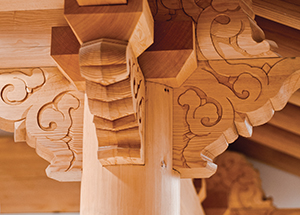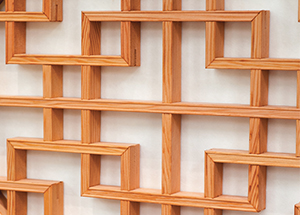Expanding Pitt’s Global View, One Room at a Time
The University of Pittsburgh’s Korean Heritage Classroom will be dedicated and opened this fall, while fundraising will commence shortly to build an Iranian Nationality Room.

Both classrooms are part of Pitt’s Nationality Rooms and Intercultural Exchange Programs, which comprise 30 classrooms on the first and third floors of the Cathedral of Learning that were designed to represent the cultures of various ethnic groups that settled in Allegheny County.
Work on the Korean Classroom began in May and intensified this summer when five master craftsmen came to Pittsburgh from South Korea—their first visit to the United States—in June to ensure the authenticity of the room. They departed in August.
“The Korean carpenters were tireless workers who were awake at the crack of dawn, every day, to ensure that the Korean Heritage Classroom lives up to the high expectations of grandeur that both the University of Pittsburgh and the Korean community have come to expect,” said E. Maxine Bruhns, director of Pitt’s Nationality Rooms and Intercultural Exchange Programs.
 When completed, the Korean Heritage Classroom will be the first new Nationality Classroom since 2012, when both the Swiss and Turkish Nationality Rooms were dedicated. The Korean Classroom’s dedication ceremony is scheduled for Nov. 15.
When completed, the Korean Heritage Classroom will be the first new Nationality Classroom since 2012, when both the Swiss and Turkish Nationality Rooms were dedicated. The Korean Classroom’s dedication ceremony is scheduled for Nov. 15.
The room’s design is inspired by the Myeongnyundang—or the Hall of Enlightenment—the main lecture hall of Korea’s Sungkyunkwan University. Built in the early 14th century, Sungkyunkwan was Korea’s foremost institution of higher learning and it remains a prominent historical landmark in Eastern Asia.
Meanwhile, Chancellor Patrick A. Gallagher recently gave official approval for the Iranian Nationality Room.
The approval paves the way for the Iranian Nationality Room Committee to launch a nationwide fundraising campaign and consider design concepts. Ali Masalehdan, committee chair, said that the room will help to educate and bridge cultural divides in Pittsburgh and beyond.
“Our hope is that by having a classroom focused on Iranian architecture and history, we can help to dispel many of the negative conceptions of Iran that are due to the soured U.S. and Iranian relationship over the last 35 years,” said Masalehdan. “People who know Iranian culture know of its influence on world history as well as its proud Iranian-American communities that have contributed greatly to the United States.”
The Nationality Rooms Program bylaws require the rooms’ designs to represent a period prior to 1787, the year of Pitt’s founding and the signing of the U.S. Constitution. Masalehdan said the Iranian Nationality Room Committee will consider a range of Iranian historical periods for architectural inspiration, dating back to the First Persian Empire in the fifth century B.C.
Masalehdan hopes that construction on the Iranian Nationality Room can begin within the next three to four years.
“More than any other single asset, the Nationality Rooms epitomize Pitt’s character by melding culture, beauty, and learning,” said Bruhns, who has served as director of the Nationality Rooms Programs for more than 50 years. “When finished, the Korean Heritage Room, the Iranian Room, and every other Nationality Room that follows them will be an enduring testament to the cultures as well as the citizens who represent those ethnicities in the city of Pittsburgh.”
Other Stories From This Issue
On the Freedom Road

Follow a group of Pitt students on the Returning to the Roots of Civil Rights bus tour, a nine-day, 2,300-mile journey crisscrossing five states.
Day 1: The Awakening
Day 2: Deep Impressions
Day 3: Music, Montgomery, and More
Day 4: Looking Back, Looking Forward
Day 5: Learning to Remember
Day 6: The Mountaintop
Day 7: Slavery and Beyond
Day 8: Lessons to Bring Home
Day 9: Final Lessons

